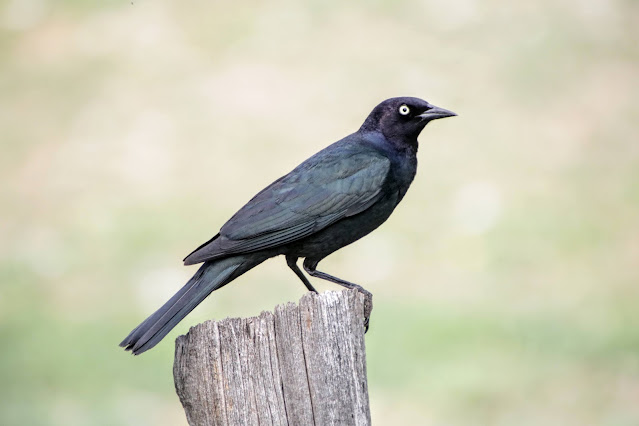Durango has always been one of my favorite ski towns. Purgatory ski resort is thirty minutes away, and Wolf Creek with its abundance of powder is just an hour and a half drive. During my frequent winter visits, I have mostly ignored the Animas River that flowed through town. In the cold weather, the waterway was gray and icy, its riverbanks lined with snow and leafless trees. However in early June, as I recently discovered, the river was flowing heavy with snowmelt, and its lush banks teamed with birds. With sunrise temperatures in the low fifties, the Animas was actually inviting me for a morning run. And as always on any trail, I was hopeful I'd encounter a variety of birds.
Even in my hotel's parking lot, I spied a magpie, apparently curious about the extensive collection of trucks. While I followed Bennett Street to reach the river, a pair of deer munched on a home's front-yard shrubs. When I arrived close to the riverfront at 32nd Street, a network of trails promised me miles of safe, scenic riverside running.
In fact I ran three miles into downtown Durango, and then back, crossing the Animas several times on pedestrian bridges. I only watched for cars at one crossing, on 32nd Street, because I opted not to use an underpass. The famous Silverton tourist trains run only two excursions a day, and I missed them on my early run. But their vintage engines and whistles are loud enough to alert you a mile before you ever see them at several crossings. And most importantly, the bird life was so appealing on my run that I walked the same route again with my camera later in the morning.
I wasn't surprised to see more magpies on the route, or mountain chickadees. Those, along with ravens, are the all-season birds I usually notice on my winter ski trips. However another year-round bird I photographed early in my walk was a delightful surprise: my first Lewis's woodpecker. True to its reputation, it was acting more like a flycatcher as it made forays from a lamppost in its hunt for insects. And uncharacteristically for a woodpecker, this beauty was quite serene as it posed for pictures. Meanwhile, the other woodpecker I encountered later in the day, a northern flicker, was as frantic and nervous as I've learned to expect from that family of birds.
Most of the other birds I witnessed were probably migratory, spending their summers in Durango during their breeding season. I was excited to see a number of members of the cardinalidae family, including summer tanagers, black-headed grosbeaks, and western tanagers, all males and as radiant as I would expect. Just as colorful was a male Bullock's oriole I spotted. Brightest and noisiest might have been the yellow warblers that seemed to inhabit every other tree I passed by. I even found one settling into a nest overhanging the trail close to downtown near the Animas Brewing Company.
There were at least three species of swallows along the river: northern rough-winged, violet-green, and cliff. The latter were busy tending to mud nests under one of the bridges crossing the Animas. I also photographed a hummingbird, probably a female, either a black-chinned or broad-tailed, the two likeliest visitors to Colorado.
In addition to the calls of red-winged blackbirds emanating from the riverside reeds, I heard song sparrows, and even photographed two. Another sparrow I spotted on my run might have been a Lincoln's. Brewer's blackbirds and American robins were certainly the most numerous of the birds I observed that day. When I peered into the thick foliage to investigate some motion along the riverbank, I frequently discovered gray catbirds.
I watched the mud-tinged Animas flowing swiftly by, seeing more thrill-seeking rafters than water birds floating by. Mallards found some safety close to an inlet near a sharp bend in the river. On an island outcrop close to the heart of downtown, I spotted what might have been a common merganser - without a photo, I'll never really know for sure. However I'm certain of the pair of Canadian geese and their four adorable goslings I photographed on the Doubletree property a short distance away.
The Animas River Trail extends seven miles in length, running mostly north and south along the river. It crosses eight bridges, four underpasses, and one tunnel, protecting runners, hikers, pedestrians, and bikers from street traffic. It also connects to local parks and other trails along the way, not counting the access it gives to neighborhoods, schools, and the many central Durango attractions. But more importantly for me the birder, the trail provides ingress to the river, not so much for the watersports but for the flora and especially the fauna.
 |
| Lewis's woodpecker in Durango. |
 |
| Magpie in Durango. |
 |
| Male Brewer's blackbird in Durango. |
 |
| Yellow warbler and its nest in Durango. |
 |
| Cliff swallow and nests in Durango. |
 |
| Gray catbird in Durango. |
 |
| Canada goose gosling in Durango. |
 |
| View of the Animas River looking south toward downtown Durango. |
Comments
Post a Comment